Related Research Articles
The banjo is a stringed instrument with a thin membrane stretched over a frame or cavity to form a resonator. The membrane is typically circular, in modern forms usually made of plastic, originally of animal skin. Early forms of the instrument were fashioned by African Americans and had African antecedents. In the 19th century, interest in the instrument was spread across the United States and United Kingdom by traveling shows of the 19th-century minstrel show fad, followed by mass-production and mail-order sales, including instruction method books. The inexpensive or home-made banjo remained part of rural folk culture, but 5-string and 4-string banjos also became popular for home parlor music entertainment, college music clubs, and early 20th century jazz bands. By the early 21st century, the banjo was most frequently associated with folk, bluegrass and country music, but was also used in some rock, pop and even hip-hop music. Among rock bands, the Eagles, Led Zeppelin, and the Grateful Dead have used the five-string banjo in some of their songs. Some famous pickers of the banjo are Ralph Stanley and Earl Scruggs.

An electric guitar is a guitar that requires external amplification in order to be heard at typical performance volumes, unlike a standard acoustic guitar. It uses one or more pickups to convert the vibration of its strings into electrical signals, which ultimately are reproduced as sound by loudspeakers. The sound is sometimes shaped or electronically altered to achieve different timbres or tonal qualities from that of an acoustic guitar via amplifier settings or knobs on the guitar. Often, this is done through the use of effects such as reverb, distortion and "overdrive"; the latter is considered to be a key element of electric blues guitar music and jazz, rock and heavy-metal guitar-playing. Designs also exist combining attributes of the electric and acoustic guitars: the semi-acoustic and acoustic-electric guitars.

The guitar is a stringed musical instrument that is usually fretted and typically has six or twelve strings. It is usually held flat against the player's body and played by strumming or plucking the strings with the dominant hand, while simultaneously pressing selected strings against frets with the fingers of the opposite hand. A guitar pick may also be used to strike the strings. The sound of the guitar is projected either acoustically, by means of a resonant hollow chamber on the guitar, or amplified by an electronic pickup and an amplifier.

The harp is a stringed musical instrument that has individual strings running at an angle to its soundboard; the strings are plucked with the fingers. Harps can be made and played in various ways, standing or sitting, and in orchestras or concerts. Its most common form is triangular in shape and made of wood. Some have multiple rows of strings and pedal attachments.

A lute is any plucked string instrument with a neck and a deep round back enclosing a hollow cavity, usually with a sound hole or opening in the body. It may be either fretted or unfretted.
A mandolin is a stringed musical instrument in the lute family and is generally plucked with a pick. It most commonly has four courses of doubled strings tuned in unison, thus giving a total of eight strings. A variety of string types are used, with steel strings being the most common and usually the least expensive. The courses are typically tuned in an interval of perfect fifths, with the same tuning as a violin. Also, like the violin, it is the soprano member of a family that includes the mandola, octave mandolin, mandocello and mandobass.

A musical ensemble, also known as a music group or musical group, is a group of people who perform instrumental and/or vocal music, with the ensemble typically known by a distinct name. Some music ensembles consist solely of instrumentalists, such as the jazz quartet or the orchestra. Other music ensembles consist solely of singers, such as choirs and doo-wop groups. In both popular music and classical music, there are ensembles in which both instrumentalists and singers perform, such as the rock band or the Baroque chamber group for basso continuo and one or more singers. In classical music, trios or quartets either blend the sounds of musical instrument families or group instruments from the same instrument family, such as string ensembles or wind ensembles. Some ensembles blend the sounds of a variety of instrument families, such as the orchestra, which uses a string section, brass instruments, woodwinds, and percussion instruments, or the concert band, which uses brass, woodwinds, and percussion.
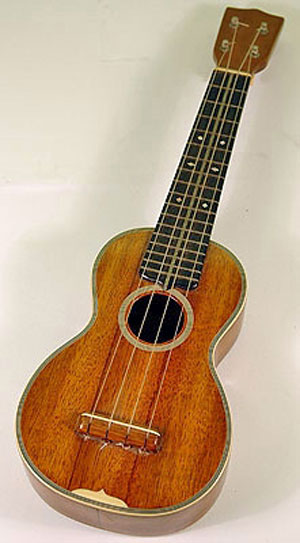
The ukulele, also called a uke, is a member of the lute family of instruments of Portuguese origin and popularized in Hawaii. It generally employs four nylon strings.
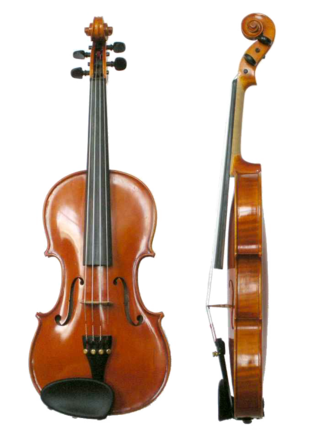
The violin, colloquially known as a fiddle, is a wooden chordophone, and is the smallest, and thus highest-pitched instrument (soprano) in regular use in the violin family. Smaller violin-type instruments exist, including the violino piccolo and the pochette, but these are virtually unused. Most violins have a hollow wooden body, and commonly have four strings, usually tuned in perfect fifths with notes G3, D4, A4, E5, and are most commonly played by drawing a bow across the strings. The violin can also be played by plucking the strings with the fingers (pizzicato) and, in specialized cases, by striking the strings with the wooden side of the bow.
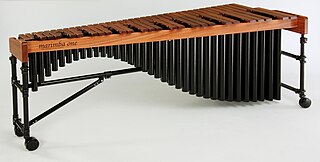
The marimba is a musical instrument in the percussion family that consists of wooden bars that are struck by mallets. Below each bar is a resonator pipe that amplifies particular harmonics of its sound. Compared to the xylophone, the marimba has a lower range. Typically, the bars of a marimba are arranged chromatically, like the keys of a piano. The marimba is a type of idiophone.

The sitar is a plucked stringed instrument, originating from the Indian subcontinent, used in Hindustani classical music. The instrument was invented in the 18th century, and arrived at its present form in 19th-century India. Khusrau Khan, an 18th-century figure of the Mughal Empire has been identified by modern scholarship as the inventor of the sitar. According to most historians, he developed the sitar from the setar, an Iranian instrument of Abbasid or Safavid origin.

The oud is a Middle Eastern short-neck lute-type, pear-shaped, fretless stringed instrument, usually with 11 strings grouped in six courses, but some models have five or seven courses, with 10 or 13 strings respectively.
"Norwegian Wood (This Bird Has Flown)", otherwise known as simply "Norwegian Wood", is a song by the English rock band the Beatles from their 1965 album Rubber Soul. It was written mainly by John Lennon, with lyrical contributions from Paul McCartney, and credited to the Lennon–McCartney songwriting partnership. Influenced by the introspective lyrics of Bob Dylan, the song is considered a milestone in the Beatles' development as songwriters. The track features a sitar part, played by lead guitarist George Harrison, that marked the first appearance of the Indian string instrument on a Western rock recording. The song was a number 1 hit in Australia when released on a single there in 1966, coupled with "Nowhere Man".

A bass instrument is a musical instrument that produces tones in the low-pitched range C2–C4. Basses belong to different families of instruments and can cover a wide range of musical roles. Since producing low pitches usually requires a long air column or string, the string and wind bass instruments are usually the largest instruments in their families or instrument classes.

Paracho de Verduzco is a small city located in Michoacán, Mexico. It is located about 100 kilometers west of the state capital Morelia. The city serves as the municipal seat for the surrounding municipality of Paracho. It has a population of 37,464.

The guitarrón mexicano (Spanish for "big Mexican guitar", the suffix -ón being a Spanish augmentative) or Mexican guitarrón is a very large, deep-bodied Mexican six-string acoustic bass guitar played traditionally in Mariachi groups. Although similar to the guitar, it is not a derivative of that instrument, but was independently developed from the sixteenth-century Spanish bajo de uña ("fingernail[-plucked] bass"). Because its great size gives it volume, it does not require electric amplification for performances in small venues. The guitarrón is fretless with heavy gauge strings, most commonly nylon for the high three and wound metal for the low three. The guitarrón is usually played by doubling notes at the octave, a practice facilitated by the standard guitarrón tuning A1 D2 G2 C3 E3 A2. Unlike a guitar, the pitch of the guitarrón strings does not always rise as strings move directionally downward from the lowest-pitched string (A2, which is the 6th string from the lowest-pitched string, is a perfect 5th below its adjacent string E3).
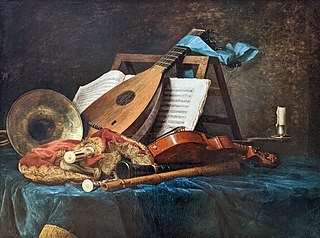
A musical instrument is a device created or adapted to make musical sounds. In principle, any object that produces sound can be considered a musical instrument—it is through purpose that the object becomes a musical instrument. A person who plays a musical instrument is known as an instrumentalist. The history of musical instruments dates to the beginnings of human culture. Early musical instruments may have been used for rituals, such as a horn to signal success on the hunt, or a drum in a religious ceremony. Cultures eventually developed composition and performance of melodies for entertainment. Musical instruments evolved in step with changing applications and technologies.
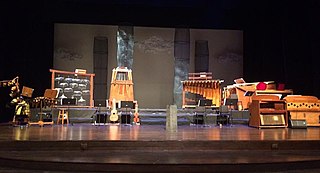
The American composer Harry Partch (1901-1974) composed using scales of unequal intervals in just intonation, derived from the natural Harmonic series; these scales allowed for more tones of smaller intervals than in the standard Western tuning, which uses twelve equal intervals. The tonal system Partch used has 43 tones to the octave. To play this music he invented and built many new instruments, with names such as the Chromelodeon, the Quadrangularis Reversum, and the Zymo-Xyl.

The veena, also spelled vina, is any of various chordophone instruments from the Indian subcontinent. Ancient musical instruments evolved into many variations, such as lutes, zithers and arched harps. The many regional designs have different names such as the Rudra veena, the Saraswati veena, the Vichitra veena and others.

The tube zither is a stringed musical instrument in which a tube functions both as an instrument's neck and its soundbox. As the neck, it holds strings taut and allows them to vibrate. As a soundbox, it modifies the sound and transfers it to the open air. The instruments are among the oldest of chordophones, being "a very early stage" in the development of chordophones, and predate some of the oldest chordophones, such as the Chinese Se, zithers built on a tube split in half. Most tube zithers are made of bamboo, played today in Madagascar, India, Southeast Asia and Taiwan. Tube zithers made from other materials have been found in Europe and the United States, made from materials such as cornstalks and cactus.
References
- Atlas Cultural de México. Música. México: INAH - Editorial Planeta. 1988. ISBN 968-406-121-8.
- 1 2 3 4 Romero, Brenda (1999). "Wood That Sings, Indian Fiddle Music of America". Ethnomusicology. Vol. 43, no. 3. University of Illinois Press. p. 568. doi:10.2307/852570. JSTOR 852570.
- ↑ Kuss, Malena, ed. (25 July 2010). Music in Latin America and the Caribbean: An Encyclopedic History: Volume 1. University of Texas Press. p. 387. ISBN 9780292788404 . Retrieved 7 July 2019.
Seri (Konkaak) people...